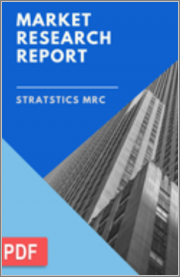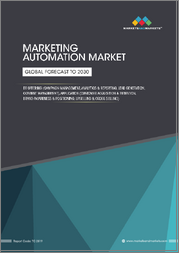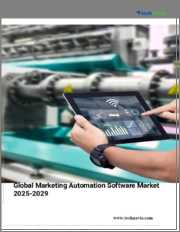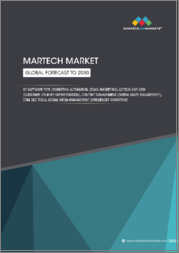
|
시장보고서
상품코드
1339931
세계의 마케팅 자동화 시장 예측(-2030년) : 구성 요소별, 용도별, 기업 규모별, 최종 사용자별, 지역별 분석Marketing Automation Market Forecasts to 2030 - Global Analysis By Component (Solutions and Services), Application (Email Marketing, Campaign Management, Mobile Applications and Other Application), Enterprise Size, End User and By Geography |
||||||
Stratistics MRC에 따르면, 세계 마케팅 자동화 시장은 2023년 59억 6,000만 달러에 이르고, 예측 기간 동안 14.8%의 연평균 복합 성장률(CAGR)로 성장하여 2030년에는 156억 8,000만 달러에 달할 것으로 예상됩니다. 예측되고 있습니다.
소프트웨어를 사용하여 번거로운 마케팅 작업을 자동화하는 것을 마케팅 자동화라고 합니다. 마케팅 팀은 생산성을 향상시킬 뿐만 아니라 소셜 미디어 게시, 이메일 마케팅, 심지어 광고 캠페인과 같은 단조로운 프로세스를 자동화하여 고객에게 보다 개인화된 경험을 제공할 수 있습니다. 이러한 프로세스는 마케팅 자동화의 기반이 되는 기술을 통해 가속화되고 단순화될 수 있습니다. 대부분의 기업들은 마케팅 자동화를 미리 작성된 이메일 시퀀스를 통해 잠재 고객을 육성하는 데 효과적인 중간 단계의 기술로 간주하고 있습니다. 용도임에도 불구하고, 이 전략은 잠재 고객과 고객이 마케팅에서 영업, 고객 관리로 이동하는 과정에서 분리된 경험을 제공할 수 있습니다.
2021년 1월 미국마케팅협회와 듀크대학교가 실시한 CMO 설문조사에 따르면, 미국 B2B 제품 마케팅 담당자들은 내년 전통적인 광고 지출이 0.61% 감소하는 반면, 디지털 마케팅 지출은 14.32% 증가할 것으로 예상했습니다.
시장 역학 :
자동화된 마케팅 솔루션이 다양한 중소기업에 도입되고 있습니다.
반복적인 작업의 부담 감소, 사물인터넷(IoT), 클라우드 컴퓨팅 및 기타 첨단 기술로의 전환, 업무 간소화, 다양한 출처의 고객 요구 사항 파악, 운영 비용 절감에 대한 요구가 증가하고 있습니다. 또한, 마케팅 자동화 도구는 교차 판매 기회, 고객 참여 강화, 고객 접촉 시간 단축, 중소기업에 대한 판매 확대 등의 이점을 제공합니다.
마케팅 자동화 도구와 다른 기업용 소프트웨어와의 통합
소비자의 구매 행동이 빠르게 변화함에 따라 소비자 여정은 더욱 복잡해지고 있으며, 마케팅 자동화 소프트웨어는 ROI를 결정하기 위해 다양한 앱에서 고객 정보를 수집하고 있습니다. 그러나 기업들은 시스템의 복잡성과 도입 비용으로 인해 새로운 솔루션과 기존 시스템을 통합하는 데 큰 어려움을 겪고 있습니다. 벤더는 고객이 마케팅 자동화 소프트웨어의 혜택을 누리기 위해서는 제안된 솔루션을 고객의 업무 시스템과 통합할 수 있어야 합니다. 공급업체의 최선의 노력에도 불구하고 예산 제한과 자원 부족으로 인해 신생 기업과 중소기업이 이러한 유기적 전략을 구현하는 데 어려움을 겪고 있으며, 이는 업계에 문제를 일으키고 있습니다.
AI와 머신러닝의 활용도 증가
마케팅을 둘러싼 환경은 지난 수십년동안, 특히 최근 몇 년동안 큰 변화를 겪었습니다. 기업들은 이제 방대한 양의 데이터에 접근할 수 있게 되었고, 모든 가능한 소스에서 데이터를 얻을 수 있게 되었습니다. 따라서 기업의 규모, 구조, 비즈니스 전략에 관계없이 혁신적인 신기술의 필요성을 인식하고 현재 기술의 한계를 이해한 기업들은 마케팅 자동화 솔루션을 활용하기 시작했습니다. 기업들에게 마케팅 자동화는 새로운 가능성을 열어주었습니다. 또한 AI와 ML은 다가올 마케팅 혁명으로 여겨지고 있습니다. 수작업, 단조로운 작업, 인건비, 인적 오류를 제거함으로써 마케팅 자동화 소프트웨어에 AI와 ML을 사용하면 기업에게 경쟁력을 제공하여 시장 성장을 가속할 수 있습니다.
기밀성 및 프라이버시 관련 우려
오늘날 SMAC 기술의 사용이 증가함에 따라 조직은 침해 사고를 피하기 위해 점점 더 엄격한 보안 및 개인 정보 보호 조치가 필요합니다. 이러한 조치를 심각하게 다루지 않으면 디지털화의 성공에 부정적인 영향을 미칠 수 있습니다. 데이터 보안 및 개인 정보 보호 문제를 적절히 처리하는 것이 중요합니다.
COVID-19의 영향
소비자들이 마케팅 자동화 소프트웨어 및 서비스의 확장성, 저비용 등의 이점을 활용하기 위해 노력하는 가운데, 코로나19 사태로 인해 모든 업종에서 마케팅 자동화 솔루션 도입이 가속화되고 있습니다. 조직이 디지털로 통합되고, 더 많은 사람들이 인터넷에 접속하고, 더 많은 사람들이 모바일 기기를 사용함에 따라 마케팅 자동화 솔루션에 대한 수요가 크게 증가하고 있습니다.
보고서 및 분석 부문은 예측 기간 동안 가장 큰 비중을 차지할 것으로 예상됩니다.
보고 및 분석 부문은 시스템이 성공을 모니터링하고, 광고 투자 수익률을 높이고, 채널 믹스를 극대화하고, 장기적인 추세를 파악할 수 있는 성과 데이터를 제공하기 때문에 유리한 성장세를 보일 것으로 예상됩니다. 또한, AI는 기업이 적은 노력으로 최신 정보를 얻고, 소비자에게 개인화된 정보와 조언을 제공하며, 챗봇과 가상 비서를 통해 일대일 인간과 같은 지원을 제공할 수 있도록 돕고 있습니다. 또한, 기술 기업들은 분석 및 마케팅 자동화, 고객관계관리(CRM), 컨텐츠 관리 시스템(CMS)을 결합하여 종합적인 솔루션을 제공하는 통합 소프트웨어 제품군을 개발하는 데 중요한 역할을 하고 있습니다.
예측 기간 동안 제조 및 유통 분야가 가장 높은 CAGR을 기록할 것으로 예상됩니다.
제조 및 유통 부문은 예측 기간 동안 가장 높은 CAGR을 기록할 것으로 예상됩니다. 제조업의 디지털화로의 전환은 기업의 보다 효율적인 고객 참여를 촉진하고 있습니다. 또한 Content Marketing Institute의 2018년조사에 따르면 기업의 약 30%가 판매 촉진 부서가 자동화되어 있으며, CRM과 마케팅 자동화의 통합은 산업 부문이 시간이 많이 소요되는 수작업을 자동화하고 일상 업무를 효율화하는 데 도움이 될 것으로 예상됩니다. 도움이 될 것입니다. 향후 몇 년동안 개별 제조 산업에서 마케팅 자동화 시스템의 사용이 가속화될 것으로 예상됩니다.
가장 큰 점유율을 차지하는 지역
아시아태평양은 인터넷 사용 증가, 인터넷 보급률 증가, 모바일 기기 사용 증가로 인해 예측 기간 동안 가장 큰 시장 점유율을 차지할 것으로 예상됩니다. 또한, 중국, 인도 등의 국가에서 제조업이 크게 확대되면서 향후 몇 년동안 마케팅 자동화 솔루션의 유용성이 높아질 것으로 보입니다. 여러 소셜 미디어 플랫폼에서 디지털 광고가 급증하면서 아시아태평양에서 마케팅 자동화 솔루션의 가치가 높아지고 있으며, WeChat, Weibo, Tieba를 포함한 중국 소셜 미디어 플랫폼은 광고의 중요한 광고의 장으로 부상하고 있으며, 기업이 고객 중심 이니셔티브를 개선하고 시장 성장을 더욱 촉진할 수 있도록 지원하고 있습니다.
CAGR이 가장 높은 지역 :
아시아태평양은 IT 투자가 크게 증가하면서 예측 기간 동안 가장 높은 CAGR을 기록할 것으로 예상되며, IoT 및 클라우드 컴퓨팅과 같은 첨단 기술의 활용이 확대됨에 따라 향후 몇 년동안 아시아태평양은 큰 성장을 보일 것으로 예상됩니다. 또한, 중국 및 인도와 같은 국가에서 제조업이 크게 확대됨에 따라 향후 몇 년동안 마케팅 자동화 솔루션의 유용성이 높아질 것으로 보입니다. 여러 기업들이 고객 유지를 위해 디지털 플랫폼 활용에 집중하고 있다는 사실로 인해 마케팅 자동화 시장은 이 지역의 유행에 따라 꾸준히 성장하고 있습니다.
무료 맞춤형 서비스 :
이 보고서를 구독하는 고객에게는 다음 중 하나의 무료 맞춤화 옵션을 제공합니다.
- 기업 프로파일
- 추가 시장 기업의 종합적인 프로파일링(최대 3개사까지)
- 주요 기업의 SWOT 분석(3개사까지)
- 지역 세분화
- 고객의 관심에 따른 주요 국가별 시장 추정 및 예측, CAGR(참고: 타당성 확인에 따라 다름)
- 경쟁사 벤치마킹
- 제품 포트폴리오, 지리적 입지, 전략적 제휴를 기반으로 한 주요 기업 벤치마킹
목차
제1장 주요 요약
제2장 서문
- 주요 요약
- 이해관계자
- 조사 범위
- 조사 방법
- 데이터 마이닝
- 데이터 분석
- 데이터 검증
- 조사 접근
- 조사 소스
- 1차 조사 정보원
- 2차 조사 정보원
- 전제조건
제3장 시장 동향 분석
- 성장 촉진요인
- 성장 억제요인
- 기회
- 위협
- 용도 분석
- 최종사용자 분석
- 신흥 시장
- COVID-19의 영향
제4장 Porter의 Five Forces 분석
- 공급 기업의 교섭력
- 바이어의 교섭력
- 대체품의 위협
- 신규 진출업체의 위협
- 경쟁 기업간 경쟁 관계
제5장 세계의 마케팅 자동화 시장 : 컴포넌트별
- 솔루션
- Cross Channel Campaign Management (CCCM)
- Real-Time Interaction Management (RTIM)
- Marketing Resource Management (MRM)
- Through Channel Marketing Automation (TCMA)
- Content Marketing Platform (CMP)
- 서비스
- 전문
- 매니지드
제6장 세계의 마케팅 자동화 시장 : 용도별
- 메일 마케팅
- 캠페인 관리
- 모바일 애플리케이션
- 인바운드 마케팅
- 리포팅 및 분석
- Lead Nurturing & Lead Scoring
- 소셜미디어 마케팅
- 영업 지원 프로그램
- 기타 용도
제7장 세계의 마케팅 자동화 시장 : 기업 규모별
- 대기업
- 중소기업
제8장 세계의 마케팅 자동화 시장 : 최종사용자별
- 교육
- 헬스케어
- 광고 및 디자인
- 제조 및 유통
- 소매
- 미디어 및 엔터테인먼트
- 은행/금융서비스/보험(BFSI)
- IT 및 텔레콤
- 금융 서비스
- 정부기관
- 기타 최종사용자
제9장 세계의 마케팅 자동화 시장 : 지역별
- 북미
- 미국
- 캐나다
- 멕시코
- 유럽
- 독일
- 영국
- 이탈리아
- 프랑스
- 스페인
- 기타 유럽
- 아시아태평양
- 일본
- 중국
- 인도
- 호주
- 뉴질랜드
- 한국
- 기타 아시아태평양
- 남미
- 아르헨티나
- 브라질
- 칠레
- 기타 남미
- 중동 및 아프리카
- 사우디아라비아
- 아랍에미리트(UAE)
- 카타르
- 남아프리카공화국
- 기타 중동 및 아프리카
제10장 주요 발전
- 계약/제휴/협업/합작투자(JV)
- 인수와 합병
- 신제품 출시
- 사업 확대
- 기타 주요 전략
제11장 기업 개요
- Acoustic, L.P
- Active Campaign
- Act-On Software
- Adobe Systems Incorporated
- Drip
- Hubspot, Inc
- Keap
- Klaviyo
- Marketo Inc
- Microsoft Corporation
- Omnisend
- Oracle
- Salesforce
- Salesfusion Inc
- SAP SE
- SAS SE
- Teradata Corporation
- Thryv
According to Stratistics MRC, the Global Marketing Automation Market is accounted for $5.96 billion in 2023 and is expected to reach $15.68 billion by 2030 growing at a CAGR of 14.8% during the forecast period. Automating tedious marketing tasks using software is known as marketing automation. In addition to increasing productivity, marketing teams may automate monotonous processes like social media posting, email marketing, and even ad campaigns to provide their clients a more individualized experience. These processes are accelerated and made simpler by the technology underlying marketing automation. The majority of companies view marketing automation as a middle-of-the-funnel technology that works well for nurturing prospects through pre-written email sequences. A disconnected experience for prospects and customers as they travel from marketing to sales to customer care might result from this strategy, even though email marketing is a wonderful application of marketing automation.
According to the CMO Survey by American Marketing Association and Duke University in January 2021, B2B product marketers in the United States suggested that their spending on traditional advertising was expected to decline by 0.61% in the following year, while the digital marketing spending was projected to increase by 14.32%.
Market Dynamics:
Driver:
Automated marketing solutions are being adopted by various small and medium-sized businesses
Due to the growing demand to lessen the burden of repetitive tasks, the move toward the internet of things (IoT), cloud computing, and other cutting-edge technologies, as well as the growing demand for streamlined business operations, capturing customer requirements from various sources, and lowering operational costs. Additionally, cross-selling opportunities, enhanced client involvement, shorter contact times, and greater sales to smaller businesses are all provided by marketing automation tools.
Restraint:
Integrating marketing automation tools with other enterprise software
The consumer journey has grown more complicated as a result of the quick changes in consumer purchasing behaviour since it now incorporates several touch points and channels. To determine the ROI, the marketing automation software gathers client information from a variety of apps. However, enterprises still have significant difficulties integrating new solutions with their current systems due to system complexity and implementation costs. The vendor must be able to integrate the suggested solution with the client's business systems in order for the customer to profit from the marketing automation software. Despite a vendor's best efforts, budget restrictions and a lack of resources prevent start-ups or smaller enterprises from implementing this organic strategy, creating a problem for this industry.
Opportunity:
A growing number of applications for AI and machine learning
The marketing environment has seen significant change during the past few decades, particularly more recently. Enterprises now have access to a vast quantity of data, and they get this data from every source imaginable. Therefore, regardless of their size, structure, or business strategy, firms have begun using marketing automation solutions after realizing the necessity for innovative new technology and comprehending the limitations of present technologies. For businesses, marketing automation has opened up new possibilities. Additionally, AI and ML are seen as the upcoming marketing revolution. By removing manual labor, monotonous jobs, personnel expenses, and human error, the use of AI and ML in marketing automation software provides businesses a competitive edge thereby propelling the market growth.
Threat:
Concerns about confidentiality and privacy
Organizations today need increasingly rigorous security and privacy measures to avoid breaches as the use of SMAC technology has increased. If these measures are not taken seriously, the success of digitalization will be negatively impacted. It's critical to adequately handle the issue of data security and privacy. The cloud-based marketing automation software has a higher prevalence of other security risks, such as account hijacking, insider threats, malware injections, unsecure Application Programming Interfaces (APIs), shared vulnerabilities, and data loss.
COVID-19 Impact:
As consumers strive to take advantage of the benefits of marketing automation software and services, such as expansions and lower cost, the COVID-19 pandemic has accelerated the adoption of marketing automation solutions across business verticals. As organizations become more digitally integrated, more people are using the internet, and more people are using mobile devices, the need for marketing automation solutions has been growing substantially.
The reporting & analytics segment is expected to be the largest during the forecast period
The reporting & analytics segment is estimated to have a lucrative growth, due to the system supports success monitoring and provides performance data to enhance advertising return on investments, maximize the channel mix, and give long-term trends. Additionally, AI is helping businesses stay current with little effort, delivering consumers personalized information and advice, and offering one-on-one human-like support through chat bots and virtual assistants. Moreover, technology firms play a crucial role in the development of integrated software suites that combine analytics marketing automation, customer relationship management (CRM), and content management system (CMS) to provide comprehensive solutions.
The manufacturing & distribution segment is expected to have the highest CAGR during the forecast period
The manufacturing & distribution segment is anticipated to witness the highest CAGR growth during the forecast period. Manufacturing industries' transition to digitization has facilitated businesses' more efficient customer engagement. Additionally, according to a 2018 research by the Content Marketing Institute, the sales and promotion departments of about 30% of firms were automated. CRM and marketing automation integration will help the industrial sector automate time-consuming manual chores and streamline everyday operations. In the upcoming years, it is projected that this will accelerate the use of marketing automation systems in the discrete manufacturing sector.
Region with largest share:
Asia Pacific is projected to hold the largest market share during the forecast period owing to the rising internet usage, increased internet penetration, and increased use of mobile devices. Additionally, the significant expansion of the manufacturing sectors in nations like China and India would increase the usefulness of marketing automation solutions in the next years. Due to a sharp increase in digital advertising across multiple social media platforms, the value of marketing automation solutions has been rising in the Asia Pacific region. Social media platforms in China, including WeChat, Weibo, and Tieba, have emerged as important venues for advertising, assisting businesses in improving their customer-focused initiatives which further drives the market growth.
Region with highest CAGR:
Asia Pacific is projected to have the highest CAGR over the forecast period, owing to significantly boosting their IT investment. Due to the growing use of cutting-edge technologies like IoT and cloud computing, Asia Pacific is anticipated to enjoy significant growth prospects in the next years. Additionally, the significant expansion of the manufacturing sectors in nations like China and India would increase the usefulness of marketing automation solutions in the next years. Due to the fact that several businesses are concentrating on using digital platforms to keep their clients, the market for marketing automation has been steadily expanding throughout this epidemic in this region.
Key players in the market:
Some of the key players profiled in the Marketing Automation Market include: Acoustic, L.P., Active Campaign, Act-On Software, Adobe Systems Incorporated, Drip, Hubspot, Inc., Keap, Klaviyo, Marketo Inc, Microsoft Corporation, Omnisend, Oracle, Salesforce, Salesfusion Inc., SAP SE , SAS SE, Teradata Corporation and Thryv
Key Developments:
- In May 2023, ActiveCampaign Introduces Content Generation Powered by AI, he beta release of ActiveCampaign AI is available now in its email designer and will provide customers with in-context content generation while building out their emails.
- In April 2023, ActiveCampaign Expands in LATAM, Invests in Improved Customer Experience, ActiveCampaign is making a larger investment in the region by expanding engineering and customer teams to improve the global customer experience and operations of the business.
- In February 2022, Adobe added mobile marketing personalization capabilities to journey optimizer that enables users to better engage their customers on smartphones. The seven capabilities include Message Designer, with which users can design personalized email, push notifications and in-app messages.
Components Covered:
- Solutions
- Services
Applications Covered:
- Email Marketing
- Campaign Management
- Mobile Applications
- Inbound Marketing
- Reporting & Analytics
- Lead Nurturing & Lead Scoring
- Social Media Marketing
- Sales Enablement Programs
- Other Applications
Enterprise Sizes Covered:
- Large Enterprises
- Small & Medium Enterprises
End Users Covered:
- Education
- Healthcare
- Advertising & Design
- Manufacturing & Distribution
- Retail
- Media & Entertainment
- BFSI
- IT & Telecom
- Financial Services
- Government
- Other End Users
Regions Covered:
- North America
- US
- Canada
- Mexico
- Europe
- Germany
- UK
- Italy
- France
- Spain
- Rest of Europe
- Asia Pacific
- Japan
- China
- India
- Australia
- New Zealand
- South Korea
- Rest of Asia Pacific
- South America
- Argentina
- Brazil
- Chile
- Rest of South America
- Middle East & Africa
- Saudi Arabia
- UAE
- Qatar
- South Africa
- Rest of Middle East & Africa
What our report offers:
- Market share assessments for the regional and country-level segments
- Strategic recommendations for the new entrants
- Covers Market data for the years 2021, 2022, 2023, 2026, and 2030
- Market Trends (Drivers, Constraints, Opportunities, Threats, Challenges, Investment Opportunities, and recommendations)
- Strategic recommendations in key business segments based on the market estimations
- Competitive landscaping mapping the key common trends
- Company profiling with detailed strategies, financials, and recent developments
- Supply chain trends mapping the latest technological advancements
Free Customization Offerings:
All the customers of this report will be entitled to receive one of the following free customization options:
- Company Profiling
- Comprehensive profiling of additional market players (up to 3)
- SWOT Analysis of key players (up to 3)
- Regional Segmentation
- Market estimations, Forecasts and CAGR of any prominent country as per the client's interest (Note: Depends on feasibility check)
- Competitive Benchmarking
- Benchmarking of key players based on product portfolio, geographical presence, and strategic alliances
Table of Contents
1 Executive Summary
2 Preface
- 2.1 Abstract
- 2.2 Stake Holders
- 2.3 Research Scope
- 2.4 Research Methodology
- 2.4.1 Data Mining
- 2.4.2 Data Analysis
- 2.4.3 Data Validation
- 2.4.4 Research Approach
- 2.5 Research Sources
- 2.5.1 Primary Research Sources
- 2.5.2 Secondary Research Sources
- 2.5.3 Assumptions
3 Market Trend Analysis
- 3.1 Introduction
- 3.2 Drivers
- 3.3 Restraints
- 3.4 Opportunities
- 3.5 Threats
- 3.6 Application Analysis
- 3.7 End User Analysis
- 3.8 Emerging Markets
- 3.9 Impact of Covid-19
4 Porters Five Force Analysis
- 4.1 Bargaining power of suppliers
- 4.2 Bargaining power of buyers
- 4.3 Threat of substitutes
- 4.4 Threat of new entrants
- 4.5 Competitive rivalry
5 Global Marketing Automation Market, By Component
- 5.1 Introduction
- 5.2 Solutions
- 5.2.1 Cross Channel Campaign Management (CCCM)
- 5.2.2 Real-Time Interaction Management (RTIM)
- 5.2.3 Marketing Resource Management (MRM)
- 5.2.4 Through Channel Marketing Automation (TCMA)
- 5.2.5 Content Marketing Platform (CMP)
- 5.3 Services
- 5.3.1 Professional
- 5.3.2 Managed
6 Global Marketing Automation Market, By Application
- 6.1 Introduction
- 6.2 Email Marketing
- 6.3 Campaign Management
- 6.4 Mobile Applications
- 6.5 Inbound Marketing
- 6.6 Reporting & Analytics
- 6.7 Lead Nurturing & Lead Scoring
- 6.8 Social Media Marketing
- 6.9 Sales Enablement Programs
- 6.10 Other Application
7 Global Marketing Automation Market, By Enterprise Size
- 7.1 Introduction
- 7.2 Large Enterprises
- 7.3 Small & Medium Enterprises
8 Global Marketing Automation Market, By End User
- 8.1 Introduction
- 8.2 Education
- 8.3 Healthcare
- 8.4 Advertising & Design
- 8.5 Manufacturing & Distribution
- 8.6 Retail
- 8.7 Media & Entertainment
- 8.8 BFSI
- 8.9 IT & Telecom
- 8.10 Financial Services
- 8.11 Government
- 8.12 Other End Users
9 Global Marketing Automation Market, By Geography
- 9.1 Introduction
- 9.2 North America
- 9.2.1 US
- 9.2.2 Canada
- 9.2.3 Mexico
- 9.3 Europe
- 9.3.1 Germany
- 9.3.2 UK
- 9.3.3 Italy
- 9.3.4 France
- 9.3.5 Spain
- 9.3.6 Rest of Europe
- 9.4 Asia Pacific
- 9.4.1 Japan
- 9.4.2 China
- 9.4.3 India
- 9.4.4 Australia
- 9.4.5 New Zealand
- 9.4.6 South Korea
- 9.4.7 Rest of Asia Pacific
- 9.5 South America
- 9.5.1 Argentina
- 9.5.2 Brazil
- 9.5.3 Chile
- 9.5.4 Rest of South America
- 9.6 Middle East & Africa
- 9.6.1 Saudi Arabia
- 9.6.2 UAE
- 9.6.3 Qatar
- 9.6.4 South Africa
- 9.6.5 Rest of Middle East & Africa
10 Key Developments
- 10.1 Agreements, Partnerships, Collaborations and Joint Ventures
- 10.2 Acquisitions & Mergers
- 10.3 New Product Launch
- 10.4 Expansions
- 10.5 Other Key Strategies
11 Company Profiling
- 11.1 Acoustic, L.P.
- 11.2 Active Campaign
- 11.3 Act-On Software
- 11.4 Adobe Systems Incorporated
- 11.5 Drip
- 11.6 Hubspot, Inc.
- 11.7 Keap
- 11.8 Klaviyo
- 11.9 Marketo Inc
- 11.10 Microsoft Corporation
- 11.11 Omnisend
- 11.12 Oracle
- 11.13 Salesforce
- 11.14 Salesfusion Inc.
- 11.15 SAP SE
- 11.16 SAS SE
- 11.17 Teradata Corporation
- 11.18 Thryv



















